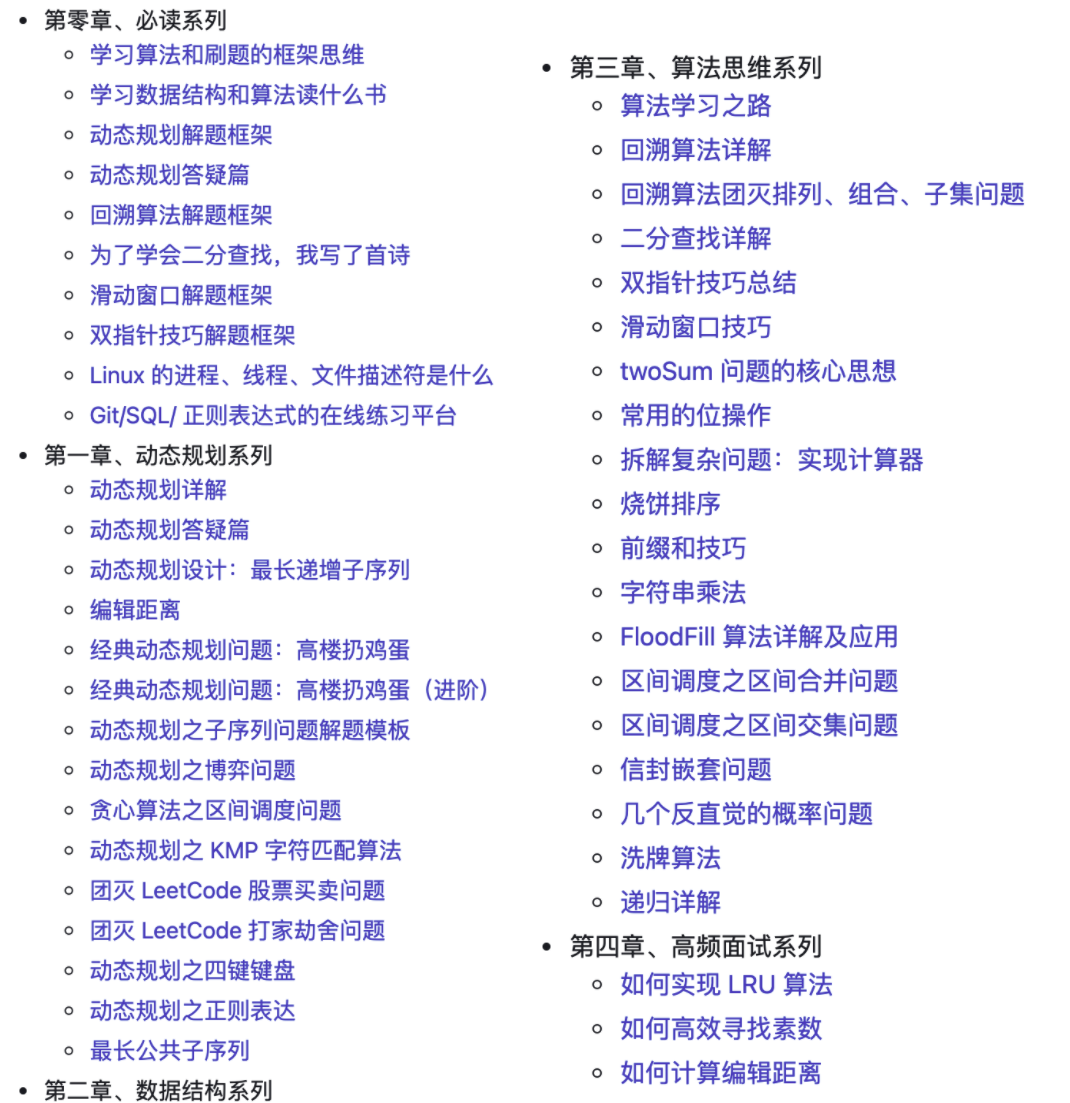2021 版 Spring Boot 基础知识复习手册(2w字,建议收藏)
点击上方 好好学java ,选择 星标 公众号
重磅资讯,干货,第一时间送达 今日推荐:分享一套基于SpringBoot和Vue的企业级中后台开源项目,这个项目有点哇塞!
个人原创100W +访问量博客:点击前往,查看更多
本文是 Spring Boot 基础知识复习手册,总共 2w 字,可以先收藏、转发。有需要的时候查阅,本文设计的知识包括:配置常用注解、Spring Boot 自动配置、配置原理、如何修改默认配置、静态资源处理、Rest映射、Spring Boot 常用注解、文件上传、拦截器、错误处理、数据层整合:MyBatis、JDBC、Druid、Redis等等。
01
@Configuration & @Bean
@Configuration
public class MyConfig {
@Bean("user")
public User getUser(){
return new User("张三",20);
}
}在配置类中使用方法对组件进行注册,它的效果等价于:
"user" class="com.wwj.springboot.bean.User">
<property name="name" value="张三"/>
<property name="age" value="20"/>
bean>需要注意的是 Spring Boot 默认会以方法名作为组件的id,也可以在 @Bean() 中指定value值作为组件的id。
在Spring中,我们可以使用@Component、@Controller、@Service、@Repository注解进行组件的注册,而对于一些第三方的类,我们无法在类上添加这些注解,为此,我们可以使用@Import注解将其注册到容器中。
@Configuration(proxyBeanMethods = true)
@Import(User.class)
public class MyConfig {
}@Conditional
该注解为条件装配注解,大量运用于SpringBoot底层,由该注解衍生出来的注解非常多:
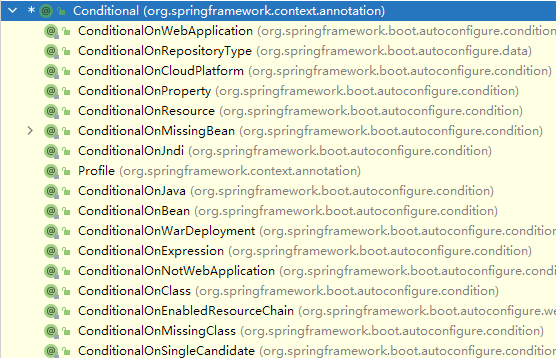
@Configuration
public class MyConfig {
@Bean("dog")
public Dog getDog(){
return new Dog();
}
@Bean("user")
@ConditionalOnBean(name = "dog")
public User getUser(){
return new User("张三",20);
}
}若如此,则SpringBoot在注册User对象之前,会先判断容器中是否已经有id为 dog 的对象,若有才创建,否则不创建。@ConditionalOnBean注解共有三种方式判断容器中是否已经存在指定的对象,除了可以判断组件的id外,也能够通过判断组件的全类名:
@Bean("user")
@ConditionalOnBean(type = "com.wwj.springboot.bean.Dog")
public User getUser(){
return new User("张三",20);
}还可以通过判断组件的类型:
@Bean("user")
@ConditionalOnBean(value = Dog.class)
public User getUser(){
return new User("张三",20);
}尤其需要注意的是,因为代码是从上至下依次执行的,所以在注册组件时的顺序要特别注意,比如:
@Configuration
public class MyConfig {
@Bean("user")
@ConditionalOnBean(value = Dog.class)
public User getUser(){
return new User("张三",20);
}
@Bean("dog")
public Dog getDog(){
return new Dog();
}
}在这段程序中,SpringBoot会先注册User对象,而此时Dog对象还没有被注册,所以会导致User对象无法注册。
而@ConditionalOnMissingBean注解的作用与@ConditionalOnBean注解正好相反,它会判断当前容器中是否不存在指定的Bean,若不存在则生效,否则不生效。
这些注解除了能够标注在方法上,还能作用于类上,当被标注在类上时,若条件成立,则配置类的所有注册方法生效;若条件不成立,则配置类的所有注册方法均不成立。
@Configuration
@ConditionalOnBean(value = Dog.class)
public class MyConfig {
@Bean("user")
public User getUser(){
return new User("张三",20);
}
@Bean("dog")
public Dog getDog(){
return new Dog();
}
}@ImportResource
该注解用于导入资源,比如现在有一个Spring的配置文件:
xml version="1.0" encoding="UTF-8"?>
<beans xmlns="http://www.springframework.org/schema/beans"
xmlns:xsi="http://www.w3.org/2001/XMLSchema-instance"
xsi:schemaLocation="http://www.springframework.org/schema/beans http://www.springframework.org/schema/beans/spring-beans.xsd">
<bean id="ls" class="com.wwj.springboot.bean.User">
<property name="name" value="李四"/>
<property name="age" value="25"/>
bean>
<bean id="tom" class="com.wwj.springboot.bean.Dog">
<property name="name" value="tom"/>
<property name="age" value="3"/>
bean>
beans>若是想将其转化为配置类,代码少一点倒还好说,当配置文件中注册的Bean非常多时,采用人工的方式显然不是一个好的办法,为此,SpringBoot提供了@ImportResource注解,该注解可以将Spring的配置文件直接导入到容器中,自动完成组件注册。
@Configuration
@ImportResource("classpath:bean.xml")
public class MyConfig {
@Bean("user")
public User getUser(){
return new User("张三",20);
}
@Bean("dog")
public Dog getDog(){
return new Dog();
}
}@ConfigurationProperties
该注解用于配置绑定,也大量运用于SpringBoot底层。首先在配置文件中编写两个键值:
user.name=zhangsan
user.age=30然后使用该注解将其绑定到User类上:
@Component
@ConfigurationProperties(prefix = "user")
public class User {
private String name;
private int age;
public User() {
}
@Override
public String toString() {
return "User{" +
"name='" + name + '\'' +
", age=" + age +
'}';
}
}但结果却有些出乎意料:
User{name='Administrator', age=30}这是因为我们将前缀 prefix 指定为了user,而user可能和我们的系统配置产生了重复,所以导致了这个问题,此时我们只需将前缀修改一下即可:
@Component
@ConfigurationProperties(prefix = "users")
public class User {
private String name;
private int age;
public User() {
}
@Override
public String toString() {
return "User{" +
"name='" + name + '\'' +
", age=" + age +
'}';
}
}前缀修改了,配置文件的内容也需要做相应的修改:
users.name=zhangsan
users.age=30需要注意的是,若是想实现配置绑定,就必须要将这个待绑定的类注册到容器中,比如使用@Component注解,当然,SpringBoot也提供了一个注解与其配套使用,它就是:@EnableConfigurationProperties 。
该注解必须标注在配置类上:
@Configuration
@EnableConfigurationProperties(User.class)
public class MyConfig {
}作用是开启指定类的配置绑定功能,它的底层其实也是通过@Import注解实现的,此时User类就无需将其注册到容器中:
@ConfigurationProperties(prefix = "users")
public class User {
private String name;
private int age;
public User() {
}
@Override
public String toString() {
return "User{" +
"name='" + name + '\'' +
", age=" + age +
'}';
}
}Spring Boot 会自动将属性值绑定到 User 类,并将其注册到容器中。Spring Boot 相关的技术文章我整理成了 PDF,关注微信公众号「Java后端」回复「666」下载这一本技术栈手册。
02
有了前面的注解基础之后,我们就能够更深入地了解Spring Boot的自动配置原理,自动配置正是建立在这些强大的注解之上的。
我们首先观察一下主启动类上的注解:
@SpringBootApplication
public class SpringbootApplication {
public static void main(String[] args) {
SpringApplication.run(SpringbootApplication.class, args);
}
}翻阅源码可以得知,@SpringBootApplication注解其实是由三个注解组成的:
@SpringBootConfiguration
@EnableAutoConfiguration
@ComponentScan(
excludeFilters = {@Filter(
type = FilterType.CUSTOM,
classes = {TypeExcludeFilter.class}
), @Filter(
type = FilterType.CUSTOM,
classes = {AutoConfigurationExcludeFilter.class}
)}
)
public @interface SpringBootApplication {
}其中@SpringBootConfiguration底层是@Configuration注解,它表示主启动类是一个配置类;而@ComponentScan是扫描注解,它默认扫描的是主启动类当前包及其子包下的组件;最关键的就是@EnableAutoConfiguration注解了,该注解便实现了自动配置。
查看@EnableAutoConfiguration注解的源码,又会发现它是由两个注解组合而成的:
@AutoConfigurationPackage
@Import({AutoConfigurationImportSelector.class})
public @interface EnableAutoConfiguration {
}我们继续查看@AutoConfigurationPackage注解的源码:
@Import({Registrar.class})
public @interface AutoConfigurationPackage {
}@Import注解我们非常熟悉,它是用来导入一个组件的,然而它比较特殊:
static class Registrar implements ImportBeanDefinitionRegistrar, DeterminableImports {
Registrar() {
}
public void registerBeanDefinitions(AnnotationMetadata metadata, BeanDefinitionRegistry registry) {
AutoConfigurationPackages.register(registry, (String[])(new AutoConfigurationPackages.PackageImports(metadata)).getPackageNames().toArray(new String[0]));
}
public Set{
return Collections.singleton(new AutoConfigurationPackages.PackageImports(metadata));
}
}这里的 Registrar 组件中有两个方法,它是用来导入一系列组件的,而该注解又被间接标注在了启动类上,所以它会将主启动类所在包及其子包下的所有组件均注册到容器中。
接下来我们继续看@EnableAutoConfiguration的第二个合成注解:@Import({AutoConfigurationImportSelector.class}) 该注解也向容器中注册了一个组件,翻阅该组件的源码:
public class AutoConfigurationImportSelector implements DeferredImportSelector, BeanClassLoaderAware, ResourceLoaderAware, BeanFactoryAware, EnvironmentAware, Ordered {
public String[] selectImports(AnnotationMetadata annotationMetadata) {
if (!this.isEnabled(annotationMetadata)) {
return NO_IMPORTS;
} else {
AutoConfigurationImportSelector.AutoConfigurationEntry autoConfigurationEntry = this.getAutoConfigurationEntry(annotationMetadata);
return StringUtils.toStringArray(autoConfigurationEntry.getConfigurations());
}
}
}这个方法是用来选择导入哪些组件的,该方法又调用了getAutoConfigurationEntry()方法得到需要导入的组件,所以我们查看该方法:
protected AutoConfigurationImportSelector.AutoConfigurationEntry getAutoConfigurationEntry(AnnotationMetadata annotationMetadata) {
if (!this.isEnabled(annotationMetadata)) {
return EMPTY_ENTRY;
} else {
AnnotationAttributes attributes = this.getAttributes(annotationMetadata);
List<String> configurations = this.getCandidateConfigurations(annotationMetadata, attributes);
configurations = this.removeDuplicates(configurations);
Set<String> exclusions = this.getExclusions(annotationMetadata, attributes);
this.checkExcludedClasses(configurations, exclusions);
configurations.removeAll(exclusions);
configurations = this.getConfigurationClassFilter().filter(configurations);
this.fireAutoConfigurationImportEvents(configurations, exclusions);
return new AutoConfigurationImportSelector.AutoConfigurationEntry(configurations, exclusions);
}
}在getCandidateConfigurations()方法处打一个断点,通过debug运行后我们可以发现,configurations集合中就已经得到了127个自动配置类:
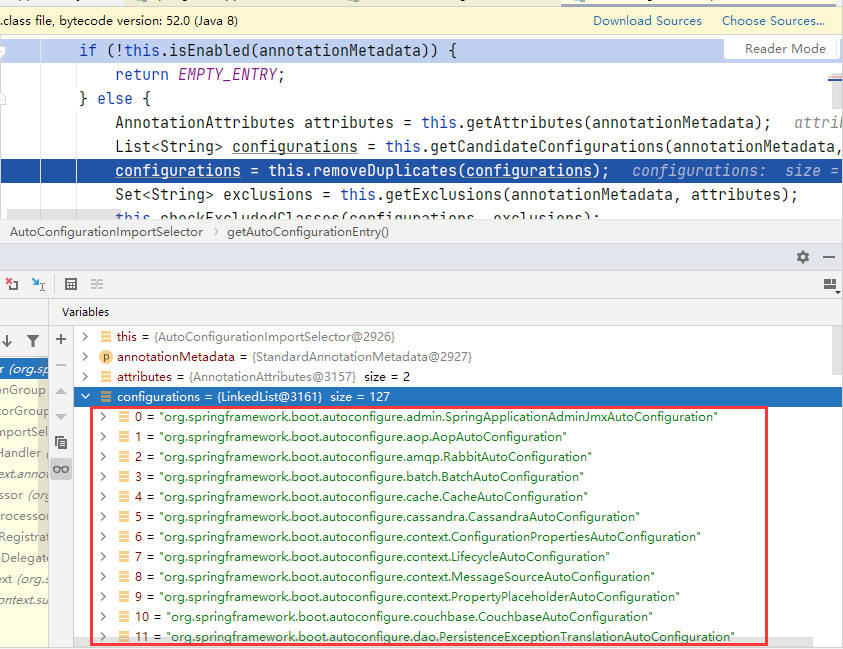
List<String> configurations = SpringFactoriesLoader.loadFactoryNames(this.getSpringFactoriesLoaderFactoryClass(), this.getBeanClassLoader());最终调用的是loadSpringFactories()方法来得到一个Map集合:
private static Map<String, List<String>> loadSpringFactories(@Nullable ClassLoader classLoader) {
MultiValueMap<String, String> result = (MultiValueMap)cache.get(classLoader);
if (result != null) {
return result;
} else {
try {
Enumeration urls = classLoader != null ? classLoader.getResources("META-INF/spring.factories") : ClassLoader.getSystemResources("META-INF/spring.factories");
LinkedMultiValueMap result = new LinkedMultiValueMap();
}
}
} 可以看到,它其实是从 META-INF/spring.factories 文件中获取的组件,我们可以看看导入的依赖中:
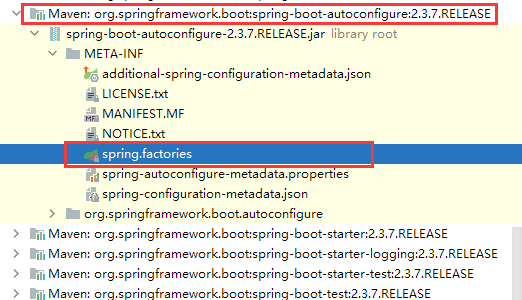
在spring-boot-autoconfigure-2.3.7.RELEASE.jar的META-INF目录下就有一个spring.factories文件,打开看看文件内容:
# Initializers
org.springframework.context.ApplicationContextInitializer=\
org.springframework.boot.autoconfigure.SharedMetadataReaderFactoryContextInitializer,\
org.springframework.boot.autoconfigure.logging.ConditionEvaluationReportLoggingListener
# Application Listeners
org.springframework.context.ApplicationListener=\
org.springframework.boot.autoconfigure.BackgroundPreinitializer
# Auto Configuration Import Listeners
org.springframework.boot.autoconfigure.AutoConfigurationImportListener=\
org.springframework.boot.autoconfigure.condition.ConditionEvaluationReportAutoConfigurationImportListener
# Auto Configuration Import Filters
org.springframework.boot.autoconfigure.AutoConfigurationImportFilter=\
org.springframework.boot.autoconfigure.condition.OnBeanCondition,\
org.springframework.boot.autoconfigure.condition.OnClassCondition,\
org.springframework.boot.autoconfigure.condition.OnWebApplicationCondition
# Auto Configure
org.springframework.boot.autoconfigure.EnableAutoConfiguration=\
org.springframework.boot.autoconfigure.admin.SpringApplicationAdminJmxAutoConfiguration,\
org.springframework.boot.autoconfigure.aop.AopAutoConfiguration,\
org.springframework.boot.autoconfigure.amqp.RabbitAutoConfiguration,\
org.springframework.boot.autoconfigure.batch.BatchAutoConfiguration,\
......文件里的内容其实就是在最开始需要注册的组件,这些组件都是一些配置类,只要项目一启动,Spring Boot就会将这些配置类全部注册到容器中。
按需开启自动配置
虽然配置类会被 Spring Boot 自动注册到容器中,但并不是每个配置类都会默认生效,SpringBoot会根据当前的场景按需开启自动配置。比如Thymeleaf模板引擎的自动配置类:
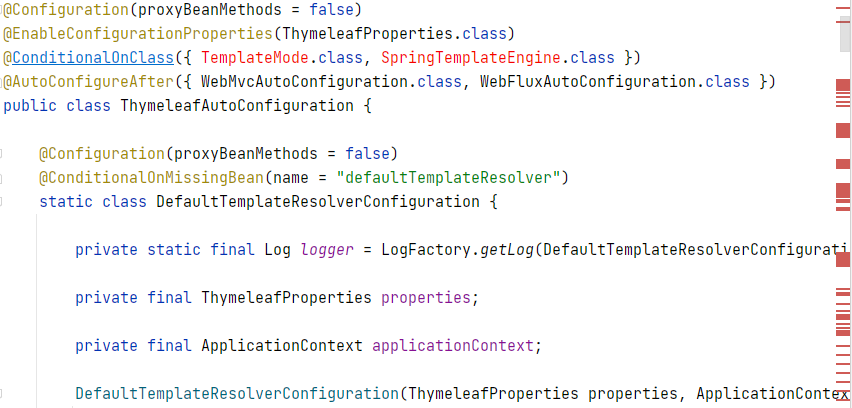
@ConditionalOnClass注解的作用是检查当前项目是否有指定的.class文件,若有则生效;否则不生效。因为我们并未引入Thymeleaf的依赖,导致TemplateMode.class和SpringTemplatengine.class都是不存在的,所以ThymeleafAutoCinfiguration并不会生效。
既然SpringBoot帮助我们进行了大量的自动配置,那么对于特殊的一些应用场景,我们该如何修改它的默认配置呢?如果你不了解SpringBoot的配置原理,那么当你需要修改默认配置时,你肯定是束手无策的。我们可以找到SpringMVC的默认配置,看看SpringBoot是如何帮我们进行配置的:
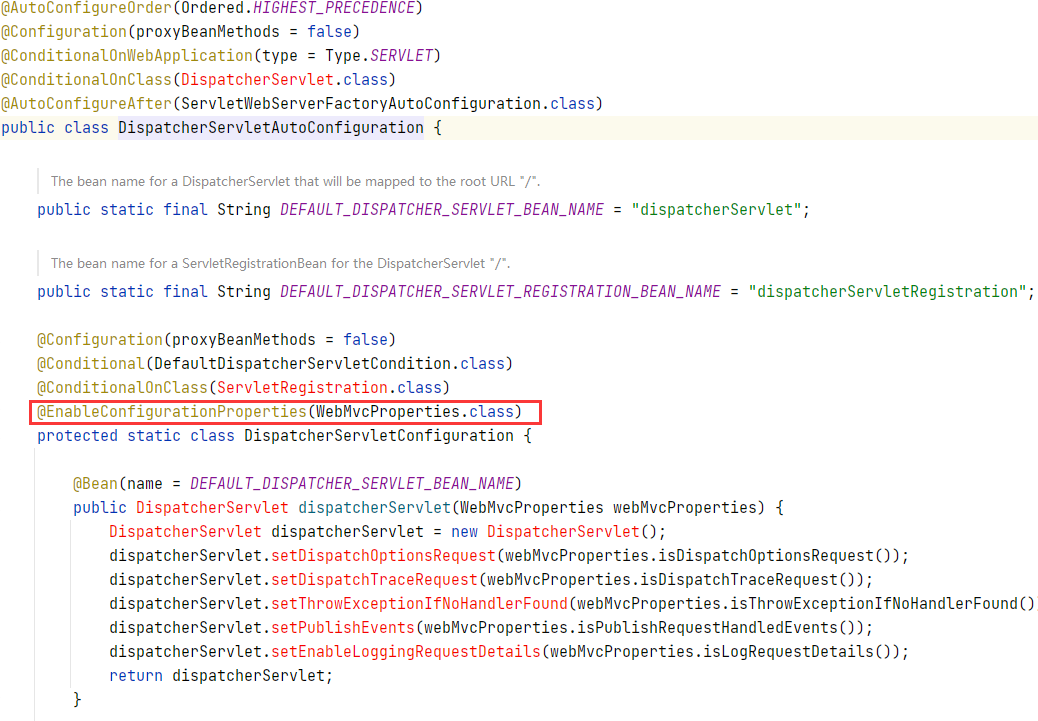
@ConfigurationProperties(prefix = "spring.mvc")
public class WebMvcProperties {
}配置绑定的前缀时spring.mvc,所以我们若是想修改SpringBoot的默认配置,则必须要将前缀写为spring.mvc,至于我们可以修改哪些配置,只需要查看该类中有哪些成员变量即可,比如:
public static class View {
private String prefix;
private String suffix;
public String getPrefix() {
return this.prefix;
}
public void setPrefix(String prefix) {
this.prefix = prefix;
}
public String getSuffix() {
return this.suffix;
}
public void setSuffix(String suffix) {
this.suffix = suffix;
}
}在WebMvcProperties类中有这样一个内部类,内部类中有prefix和suffix两个成员变量,它们是分别用来设置视图的前缀和后缀的,所以我们若想进行配置,则需要在配置文件中这样编写:
spring.mvc.view.prefix=/views/
spring.mvc.view.suffix=.html传统的Spring开发Web需要编写大量的配置,而使用SpringBoot将免去编写配置的操作,直接面向业务逻辑开发,一起来看看该如何使用SpringBoot进行Web开发吧!
Web开发
/static /public /resources /META-INF/resources
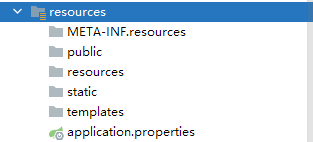
也可以通过配置来设置资源的访问前缀:
spring.mvc.static-path-pattern=/resspring.web.resources.static-locations=classpath:/myImg欢迎页
<html lang="en">
<head>
<meta charset="UTF-8">
<title>Titletitle>
head>
<body>
<h1>SpringBoot Index!h1>
body>
html>
第二种方式是通过Controller处理/index请求:
@Controller
public class HelloController {
@RequestMapping("/")
public String toIndex(){
return "hello";
}
}Favicon
favicon.ico 的图片放在静态资源目录下即可: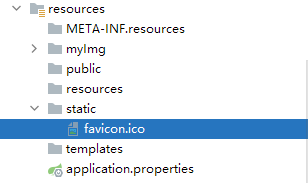
Rest映射
<html lang="en">
<head>
<meta charset="UTF-8">
<title>Titletitle>
head>
<body>
<form action="/user" method="get">
<input value="Get提交" type="submit">
form>
<form action="/user" method="post">
<input value="Post提交" type="submit">
form>
<form action="/user" method="post">
<input type="hidden" name="_method" value="DELETE">
<input value="Delete提交" type="submit">
form>
<form action="/user" method="post">
<input type="hidden" name="_method" value="PUT">
<input value="Put提交" type="submit">
form>
body>
html>@RestController
public class HelloController {
@GetMapping("/user")
public String getUser(){
return "Get";
}
@PostMapping("/user")
public String postUser(){
return "Post";
}
@DeleteMapping("/user")
public String deleteUser(){
return "Delete";
}
@PutMapping("/user")
public String putUser(){
return "Put";
}
}spring.mvc.hiddenmethod.filter.enabled=true04
常用参数及注解
@PathVariable
@GetMapping("/user/{id}")
public String getUser(@PathVariable("id") Integer id){
return id + "";
}@RequestHeader
@GetMapping("/header")
public String getHeader(@RequestHeader("User-Agent") String userAgent){
return userAgent;
}@GetMapping("/header")
public Map getHeader(@RequestHeader Map headers){
return headers;
} @RequestParam
@GetMapping("/param")
public String getParam(@RequestParam("name") String name,
@RequestParam("age") Integer age){
return name + ":" + age;
}zhangsan:20 。@CookieValue
@GetMapping("/cookie")
public String getCookie(@CookieValue("Idea-8296e76f") String cookie) {
return cookie;
}@GetMapping("/cookie")
public String getCookie(@CookieValue("Idea-8296e76f") Cookie cookie) {
return cookie.getName();
}@RequestBody
@PostMapping("/body")
public String getBody(@RequestBody String content) {
return content;
}
<html lang="en">
<head>
<meta charset="UTF-8">
<title>Titletitle>
head>
<body>
<form action="/body" method="post">
账号:<input type="text" name="username">
<br>
密码:<input type="text" name="password">
<br>
<input type="submit" value="提交">
form>
body>
html>username=admin&password=123 。@RequestAttribute
@GetMapping("/success")
public String success(@RequestAttribute("msg") String msg){
return msg;
}@MatrixVariable
@GetMapping("/matrix/{path}")
public String getMatrix(@MatrixVariable("name") String name,
@MatrixVariable("age") Integer age,
@PathVariable("path") String path) {
return path + "---" + name + ":" + age;
@Configuration
public class MyConfig {
@Bean
public WebMvcConfigurer webMvcConfigurer(){
return new WebMvcConfigurer() {
@Override
public void configurePathMatch(PathMatchConfigurer configurer) {
UrlPathHelper urlPathHelper = new UrlPathHelper();
urlPathHelper.setRemoveSemicolonContent(false);
configurer.setUrlPathHelper(urlPathHelper);
}
};
}
}test---zhangsan:20 。05
拦截器
public class LoginInterceptor implements HandlerInterceptor {
@Override
public boolean preHandle(HttpServletRequest request, HttpServletResponse response, Object handler) throws Exception {
HttpSession session = request.getSession();
Object user = session.getAttribute("user");
if(user != null){
return true;
}
response.sendRedirect("/toLogin");
return false;
}
@Override
public void postHandle(HttpServletRequest request, HttpServletResponse response, Object handler, ModelAndView modelAndView) throws Exception {
}
@Override
public void afterCompletion(HttpServletRequest request, HttpServletResponse response, Object handler, Exception ex) throws Exception {
}
}@Configuration
public class MyWebMvcConfig implements WebMvcConfigurer {
@Override
public void addInterceptors(InterceptorRegistry registry) {
registry.addInterceptor(new LoginInterceptor())
.addPathPatterns("/**")
.excludePathPatterns("toLogin", "/css/**", "/js/**", "/fonts/**", "/images/**");
}
}文件上传
<html xmlns:th="http://www.thymeleaf.org">
<head>
<meta charset="UTF-8">
<title>Titletitle>
head>
<body>
<form action="/upload" method="post" enctype="multipart/form-data">
<input type="file" name="f">
<input type="submit" value="上传">
form>
body>
html>编写控制方法: @RestController
public class FileController {
@PostMapping("/upload")
public String upload(@RequestPart("f") MultipartFile file){
String name = file.getOriginalFilename();
long size = file.getSize();
return name + ":" + size;
}
}

若是上传多个文件,则先修改表单信息:
method="post" enctype="multipart/form-data">
<input type="file" name="f" multiple>
<input type="submit" value="上传">
@PostMapping("/upload")
public String upload(@RequestPart("f") MultipartFile[] file){
return file.length + "";
}@PostMapping("/upload")
public String upload(@RequestPart("f") MultipartFile[] file) throws IOException {
for (MultipartFile multipartFile : file) {
if(!multipartFile.isEmpty()){
String filename = multipartFile.getOriginalFilename();
multipartFile.transferTo(new File("E:\\" + filename));
}
}
return "success";
}spring.servlet.multipart.max-file-size=30MB # 配置单个文件上传大小限制
spring.servlet.multipart.max-request-size=100MB # 配置总文件上传大小限制07
错误处理

然而一般情况下,我们都不会选择出异常时显示这个页面,而是想要显示我们自己定制的页面,为此,我们可以在/static或/templates目录下新建一个error目录,并在/error目录下放置命名为4xx、5xx的页面,SpringBoot会自动帮助我们解析。
此时当出现5xx的异常时,SpringBoot会自动跳转至5xx.html页面,当然你也可以对每个状态码都做一个页面进行对应,比如放置500.html、501.html、502.html文件,当服务器出现对应的异常时,就会跳转至对应的页面。
数据层
下面, 我们将探究SpringBoot与数据访问层框架的整合与使用。Spring Boot 与其他第三方中间件整合的技术文章也发布过,我整理成了 PDF,关注微信公众号「Java后端」回复「666」下载这一本技术栈手册。
JDBC
<dependency>
<groupId>org.springframework.bootgroupId>
<artifactId>spring-boot-starter-data-jdbcartifactId>
dependency>
<dependency>
<groupId>mysqlgroupId>
<artifactId>mysql-connector-javaartifactId>
<version>5.1.49version>
dependency>spring.datasource.url=jdbc:mysql:
spring.datasource.username=root
spring.datasource.password=123456
spring.datasource.driver-class-name=com.mysql.jdbc.Driver@SpringBootTest
class SpringbootApplicationTests {
@Autowired
private JdbcTemplate jdbcTemplate;
@Test
void contextLoads() {
List<String> names = jdbcTemplate.queryForList("select name from student",String.class);
for (String name : names) {
System.out.println(name);
}
}
}Druid
<dependency>
<groupId>com.alibabagroupId>
<artifactId>druid-spring-boot-starterartifactId>
<version>1.1.10version>
dependency># 开启Druid的监控页功能
spring.datasource.druid.stat-view-servlet.enabled=true
# 开启防火墙功能
spring.datasource.druid.filter-class-names=stat,wall
# 配置监控页的用户名和密码
spring.datasource.druid.stat-view-servlet.login-username=admin
spring.datasource.druid.stat-view-servlet.login-password=123
# 开启Druid的Web监控功能
spring.datasource.druid.web-stat-filter.enabled=true
# 配置监控哪些请求
spring.datasource.druid.web-stat-filter.url-pattern=...

MyBatis
<dependency>
<groupId>org.mybatis.spring.bootgroupId>
<artifactId>mybatis-spring-boot-starterartifactId>
<version>2.1.4version>
dependency>
@Mapper
public interface StudentMapper {
Student getStu(Integer id);
}xml version="1.0" encoding="UTF-8"?>
<mapper namespace="com.wwj.springboot.dao.StudentMapper">
<select id="getStu" resultType="com.wwj.springboot.bean.Student">
select * from student where id = #{id}
select>
mapper># 配置Mapper配置文件的位置
mybatis.mapper-locations=classpath:mappers@SpringBootTest
class SpringbootApplicationTests {
@Autowired
private StudentMapper studentMapper;
@Test
void contextLoads() {
Student stu = studentMapper.getStu(1);
System.out.println(stu);
}
}Redis
<dependency>
<groupId>org.springframework.bootgroupId>
<artifactId>spring-boot-starter-data-redisartifactId>
dependency># 主机地址
spring.redis.host=172.16.136.196@SpringBootTest
class SpringbootApplicationTests {
@Autowired
private StringRedisTemplate redisTemplate;
@Test
void contextLoads() {
ValueOperations<String, String> operations = redisTemplate.opsForValue();
operations.set("name","zhangsan");
String name = operations.get("name");
System.out.println(name);
}
}<dependency>
<groupId>redis.clientsgroupId>
<artifactId>jedisartifactId>
dependency>spring.redis.client-type=jedis最后,再给大家分享一份很好的算法刷题指南,我们都知道面试的不可避免的就是手撕代码,而且一般都是很难掌握的,我在前面面试中就是每天刷题,很费时间,也是很辛苦的,今天给大家推荐份来自字节跳动大佬的算法手册,我看过,感觉很不错,大家可以先看一下下面的内容: 点击关注下方公众号,回复「算法」获取

